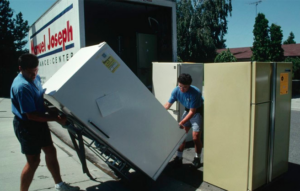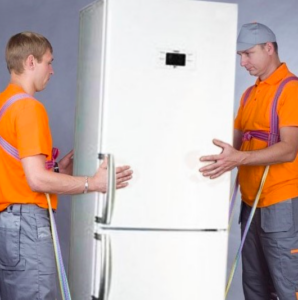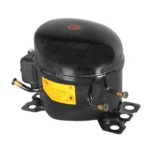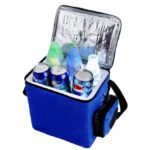Is it possible to transport a refrigerator in a lying position? Transportation rules

Is it possible to transport a refrigerator in a lying position? This is a question that sooner or later worries everyone who uses a refrigerator. And if you consider that a large number of people use the refrigerator, then the question is quite relevant.
There are rules and recommendations for transporting refrigeration devices that must be taken into account. For example, most manufacturers of refrigeration devices do not recommend transporting refrigerators lying down. And some, even if the device is transported horizontally, automatically disclaim obligations for warranty repairs and replacement of the device.
At the same time, the refrigerator is a large-sized device and its transportation in a vertical position in most private cars is simply impossible for technical reasons. Therefore, you have to rent large cars, but this is not always the solution. For example, you want to move your “old” refrigerator to your dacha, buying a new one instead, and you don’t want to spend extra money at all. In fact, there is a way out of this situation and you can still transport the refrigerator lying down, but be careful.
The content of the article
Is it possible to transport a refrigerator lying down?
So, we have determined that most refrigerator manufacturers do not recommend and even prohibit the transportation of refrigeration devices in a “lying position.” At the same time, some manufacturers still do not exclude this possibility and clearly describe in the operating instructions how to properly transport a refrigerator of a particular model in a “lying position”. Therefore, first of all, read the instructions. Why is it important? Because if the manufacturer allows the refrigerator to be transported lying down, then this can only be done under certain conditions and on a certain side.
If you are buying a new refrigerator, then there should be no problem finding out the side of horizontal transport, since this information should be on the packaging itself. At the same time, the manufacturer took care of packaging the refrigerator for safe horizontal transportation.
If you want to transport an old refrigerator, and the instructions from the manufacturer are lost somewhere, then read our article to the end and study our recommendations to keep the refrigeration device in working order during transportation.

How to transport a refrigerator lying down
The refrigerator only seems reliable and monolithic. In fact, this is a very fragile device. The “pain point” of a refrigeration device is the cooling system, which can be damaged during horizontal transportation.
Recommendations for horizontal transportation of the refrigerator:
- Initial preparatory process. It is clear that the refrigerator must be transported completely empty.That is, first you need to remove all the products from it, then disconnect it from the power supply and wait for the device to completely defrost. While the refrigeration unit is defrosting, you can remove all moving elements from it: shelves, drawers and niches. Then carefully pack them separately and prepare them for transportation. It is possible to pack them in paper or cloth, or not to pack them at all if you plan to transport them in the cabin of a vehicle.
- Find out on which side of the refrigerator it is allowed to be transported lying down. If there are no instructions, then you can determine the side yourself by looking at the compressor at the back of the refrigeration unit. The principle is this: the tube through which the refrigerant comes from the compressor should be oriented upward. This is very important, because in this position the oil from the compressor will flow into the reverse part of the circuit, and then, after starting the refrigerator, it will flow back into the compressor. If you neglect this rule, then the oil will flow further into the cooling circuit, and then, when the refrigeration device is turned on, the refrigerant will drive it further through the cooling system, tightly clogging the smallest tubes and thereby rendering the refrigeration device inoperative. Determining the required compressor tube is quite simple: after you have disconnected the refrigeration device from the network, after 5-10 minutes, carefully feel the tubes coming out of the compressor with your hands. Those tubes that will be hot will be the ones that should be oriented upward. If your compressor only has tubes on one side, then that side should be facing up. If it is possible to fix the compressor with special bolts, then do so.
- Refrigerator packaging.Before packing your refrigerator, be sure to secure the doors to prevent them from opening during transportation. Sometimes the doors are removed altogether while the refrigerator is being moved. It is very good if you still have the original packaging with foam elements from your device, as they provide ideal conditions for transportation. But, if the refrigerator is many years old, then the packaging is unlikely to be preserved. At this stage, your task is to protect the outer casing of the refrigerator. This can be done in different ways: wrapped in thick paper, cardboard, bubble wrap, etc. Here you can use your imagination, the main thing is that the outer “packaging” helps protect the body of the refrigeration device from minor impacts and shaking, which can damage the cooling system.
As you can see, the most basic task when transporting a refrigerator horizontally is determining the side of transportation. Everything else is up to you, but the better you protect the refrigerator from external influences, the greater the chance that it will reach its new destination unharmed.
Is it possible to transport a refrigerator in a lying position: what to look for
There are several important points before and after, as well as during transportation, that you need to pay attention to. For example:
- Horizontal transport side. We described how to determine the side a little higher. The refrigeration unit may only be transported on its rear side if this condition is described in its instructions. If you have not found the instructions or it does not describe that you can do this, then do not take risks and do not experiment, but transport the refrigeration device on its side. The situation is exactly the same with the front wall of the refrigerator. From practice: most manufacturers of refrigeration devices strictly prohibit transporting the device on the back and front sides.
- After horizontal transportation you need to wait. You cannot turn on the refrigeration device immediately after you have installed it in a new location, since it needs to “settle” for some time, during which the oil will collect back inside the compressor. If you transported the refrigeration device in winter, then you need to let it “settle” for about a day, at least 15-16 hours. If the refrigeration device was transported in the summer, then it is necessary to let it “catch its breath” for 6-8 hours. The most interesting thing is that when transporting vertically, the refrigerator also needs to be allowed to “catch its breath,” but in half as much time. If you do not allow it to settle, then when starting up the refrigeration device can easily fail permanently.
- Precautionary measures may not prevent the refrigeration unit from breaking down. The ideal transportation option is a vertical position. The horizontal position of the refrigeration device, even with a very careful approach, is much more dangerous for transportation than the vertical one, so it is better to use it only when absolutely necessary.
Conclusion
Can the refrigerator be transported horizontally? It is certainly possible if there is no other choice and you decide to approach this action with all responsibility. Important:
- correctly determine the side of transportation;
- pack the refrigerator well and protect it from external influences;
- It is good to secure the refrigerator during transportation, because any unnecessary movement can damage it.




